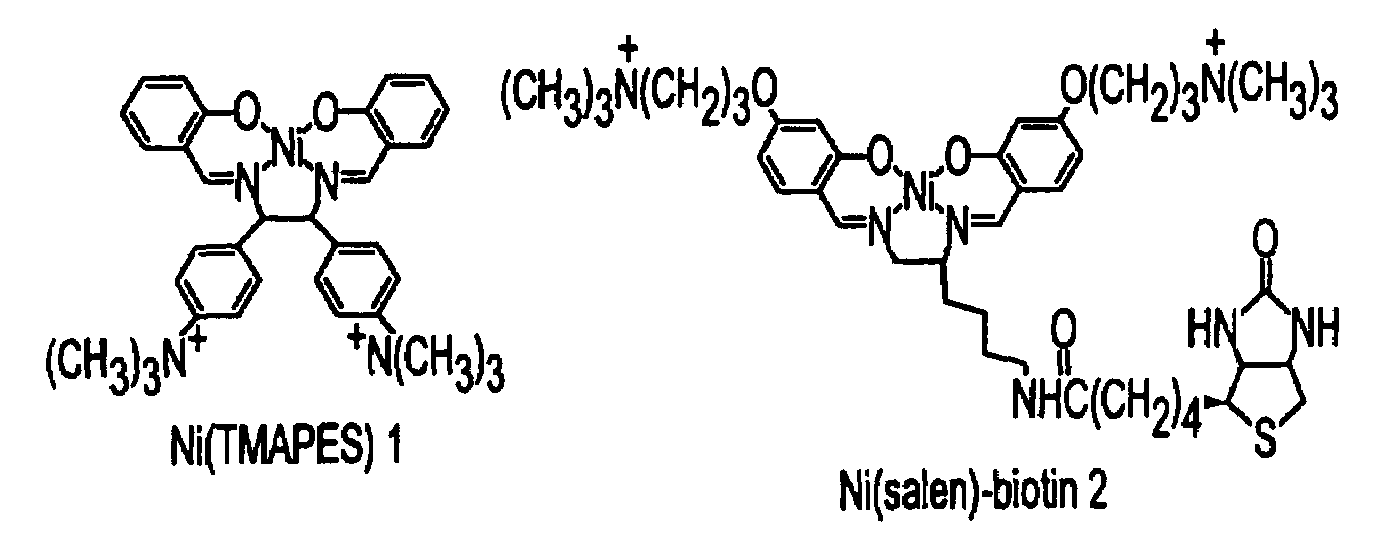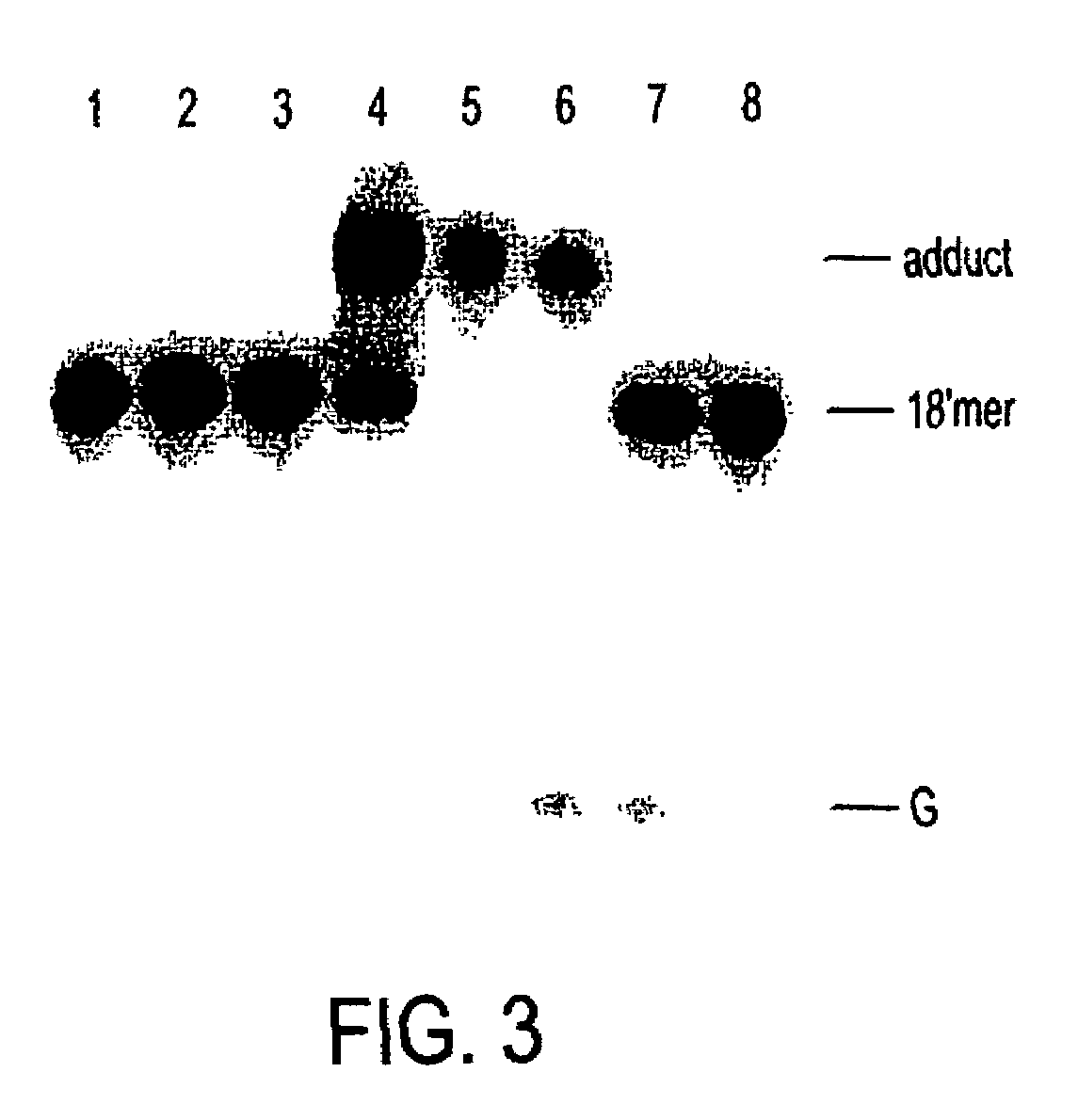Nickel-based reagents for detecting DNA and DNA-protein contacts
a technology of dna and dna-protein, which is applied in the field of nickel-based reagents, can solve the problems of not being useful in coupling to nucleic acid bases, not using current technology that uses a nickel-based complex to covalently, and not revealing or suggesting the covalent linkage between a nickel-containing complex and a specific nucleotid
- Summary
- Abstract
- Description
- Claims
- Application Information
AI Technical Summary
Benefits of technology
Problems solved by technology
Method used
Image
Examples
example 1
Synthesis and Activity of Ni(II)-Salen-Biotin Complex 2
[0104]The oxidation and coordination chemistry of transition metal ions offer substantial opportunities for selective recognition and modification of nucleic acids. (Sigel, H., Sigel, A. Eds.; Marcel Dekker: Metal Ions in Biological Systems, Vols. 32 and 33; Dekker: New York, 1996.) (Pyle, A. M; Barton, J. K. Prog. Inorg. Chem. 1990, 38, 413-475.) Certain nickel complexes in particular have demonstrated alternative abilities to oxidize and couple with highly accessible guanine residues in the presence of O2 and sulfite (Muller, J. G.; Hickerson, R. P.; Perez, R. J.; Burrows, C. J. J. Am. Chem. Soc. 1997, 119, 1501-1506.) (Stemmler, A. J.; Burrows, C. J. J. Am. Chem. Soc. 1999, 121, 6956-6957.) or peracids such as monoperoxysulfate or monoperoxyphthalate. (Burrows, C. J.; Rokita, S. E. Acc. Chem. Res. 1994, 27, 295-301.) (Burrows, C. J.; Rokita, S. E. In Metal Ions in Biological Systems, Vol. 32; Sigel, H., Sigal, A. Eds. Dekker:...
example 2
Materials and Methods used in the Synthesis of Ni(Salen)-Biotin Conjugates 2 Depicted in FIG. 2
[0111]General. 1H and 13C NMR spectra were recorded on Bruker DPX 400 and 500 spectrometers. Chemical shifts are reported as δ values relative to internal standards such as CHCl3, CH3OH or CH3CN. Mass spectra were determined using VG 7070E (FAB) and Micromass Quattro II triple quadrupole (electrospray) instruments. Column chromatography was performed with Merck kieselgel 60 silica (230 ASTM). CH2Cl2 was distilled from calcium hydride; EtOH was distilled from Mg; DMF was distilled from MgSO4; and TFA was distilled from P2O5. Other solvents and chemicals were used as received.
(S)-N′-(Benzyloxycarbonyl)-1,5-diaminopentane. (S)-1-Cyano-N1-(benzyloxycarbonyl)-N5-(tert-butyloxycarbonyl)-1,5-diaminopentane (Routier, S.; Bernier, J -L.; Waring, M. J.; Colson, P.; Houssier, C.; Bailly, C. J. Org. Chem. 1996, 61, 2326-2331. (b) Routier, S.; Cotelle, N.; Catteau, J. -P.; Bernier, J. -L.; Waring, M. J...
example 3
Preparation of Salen-XaaHis Motif for Metal-Mediated Oxidative DNA-Peptide Cross-Linking
[0115]Metallopeptide motifs of the N-terminal sequence XaaXaaHis, wherein histidine resides in the third position of the peptide, were first described for albumins (Harford, C.; Sarkar, B. Acc. Chem. Res. 1997, 30, 123-130.) and later utilized as redox-active bioconjugates for DNA cleavage (Mack, D. P.; Iverson, B. L.; Dervan, P. B. J. Am. Chem. Soc. 1988, 110, 7572-7574.) (Shullenberger, D. F.; Eason, P. D.; Long, E. C. J. Am. Chem. Soc. 1993, 115, 11038-11039.) (Nagaoka, M.; Hagihara, M.; Kuwahara, J.; Sugiura, Y. J. Am. Chem. Soc. 1994, 116, 4085-4086.) and protein-protein cross-linking. (Brown, K. C.; Yang, S. -H.; Kodadek, T. Biochemistry 1995, 34, 4733-4739.) Metallosalens are another class of tetradentate ligands that have seen applications to DNA chemistry. (Burrows, C. J.; Rokita, S. E. Acc. Chem. Res. 1994, 27, 295-301.) (Morrow, J. T.; Kolasa, K. A. Inorg. Chim. Acta 1992, 195, 245.) ...
PUM
| Property | Measurement | Unit |
|---|---|---|
| pH | aaaaa | aaaaa |
| temperature | aaaaa | aaaaa |
| temperature | aaaaa | aaaaa |
Abstract
Description
Claims
Application Information
 Login to View More
Login to View More - R&D
- Intellectual Property
- Life Sciences
- Materials
- Tech Scout
- Unparalleled Data Quality
- Higher Quality Content
- 60% Fewer Hallucinations
Browse by: Latest US Patents, China's latest patents, Technical Efficacy Thesaurus, Application Domain, Technology Topic, Popular Technical Reports.
© 2025 PatSnap. All rights reserved.Legal|Privacy policy|Modern Slavery Act Transparency Statement|Sitemap|About US| Contact US: help@patsnap.com



